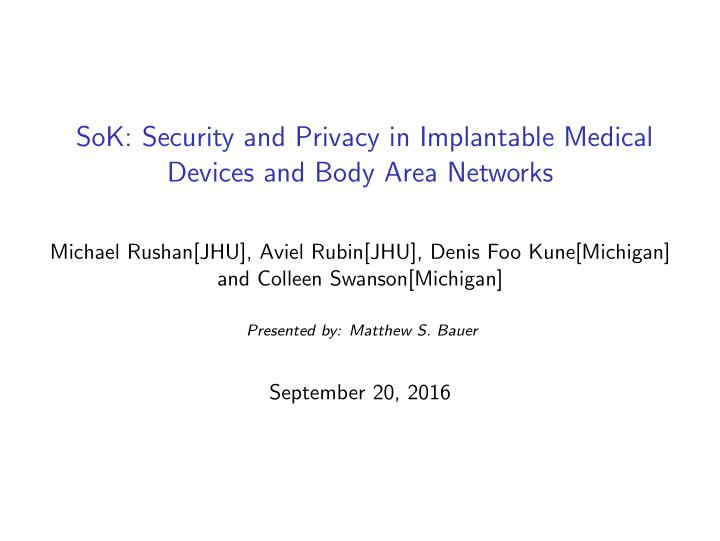



SoK: Security and Privacy in Implantable Medical Devices and Body Area Networks Michael Rushan[JHU], Aviel Rubin[JHU], Denis Foo Kune[Michigan] and Colleen Swanson[Michigan] Presented by: Matthew S. Bauer September 20, 2016
Implantable medical devices (IMDs)
Body area networks Wireless network of heterogeneous devices that are wearable/implantable comprised of sensors, actuators and a sync low power/size nodes transmission limitations stricter reliability requirements
Security and privacy design objectives Privacy goals: Device existence privacy (Device type privacy) Device ID privacy Measurement and log privacy Bearer privacy No tracking
Threats - Sensors Signal interference intentional/accidental signal injection could alter therapy Signal containment physiological signals may not stay within body private data leakage
Cardiac Implantable Electrical Devices - Signal Injection 1 By adding intentional interference to a CIED to mimic particular cardiac waveforms, it was shown that is it possible to alter the therapy delivered by the device (causing pacing inhibitions and defibrillation). Figure: The median maximum distance at which a pacing inhibition or defibrillation was observed for 4 studied devices in various mediums. 1 Ghost Talk: Mitigating EMI Signal Injection Attacks against Analog Sensors
Threats - Software Software bugs have resulted in over 500 FDA recalls between 2009 and 2011 2006-2011 software recalls by severity: 33% of class I (chance of harm) 66% of class II (temporary effects) 77% of class II (non-complaint)
Challenges in software testing Failure to apply known engineering techniques / closed design Difficulty in modeling human body Recent efforts in building models of human hearts Databases of cardiac data (e.g. MIT PhysioNet portal) Where should data be obtained from? How much data is enough for testing?
Threats - Telemetry Some existing devices lack authentication replay eavesdropping injection DOS Traditional crytpo often not applicable limited power/processing emergency access device identification
Securing device telemetry: biometric authentication Key idea: Use physiological values as a source of randomness for key establishment protocols Physiological values Electrocardiograms heart rate blood glucose blood pressure Heart-to-Heart protocol
Challenges in biometric authentication Need more rigorous analysis of entropy sources and protocols Flaws found in biometric protocols (OPFKA, IMDGuard) allow key space reduction attacks Do these protocols handle real world noise? Is the randomness property extracted from physiological entropy sources?
Securing device telemetry: distance-bounding protocols Key idea: measure delays between transmissions between devices to establish proximity. Distance bounds can be computed over various signals such as RF or ultrasonic sound ( > 20 kHz)
Distance-bounding protocol 2 2 Proximity-based Access Control for Implantable Medical Devices
Securing device telemetry: out of band authentication Key idea: use audio and visual channels to exchange authentication (key information) Examples: low frequency audio channel to transmit a random key ultra-violet or visible tattoos to record permanent key information
Securing device telemetry: external wearable devices Key idea: IMD to programmer communicated is mediated through a wearable device.
Challenges in designing external wearable devices Need to fail open. What communication protocols between IMD and the mediator should be used? Can jamming or the proxy be circumvented?
Securing device telemetry: anomaly detection Key idea: Observe and characterize patterns in device communications to detect unwanted behavior. Use cases: Preventing denial of service attacks Identify abnormal IMD communication by signal characteristics (strength, time, angle, etc..)
Challenges in anomaly detection Emergency scenarios Where is all of the computational overhead of anomaly detecting going to be offloaded to? What to do in the case of an anomaly? Alerting the patient Blocking transmissions to the IMD
Discussion What is the likelihood of targeted attacks on IMD’s? How does this affect security design decisions? What do you think is the best approach to securing the telemetry interface? What are the right assumptions about attacker capabilities in the various contexts we have discussed? Do we need more data to answer this question?
Recommend
More recommend